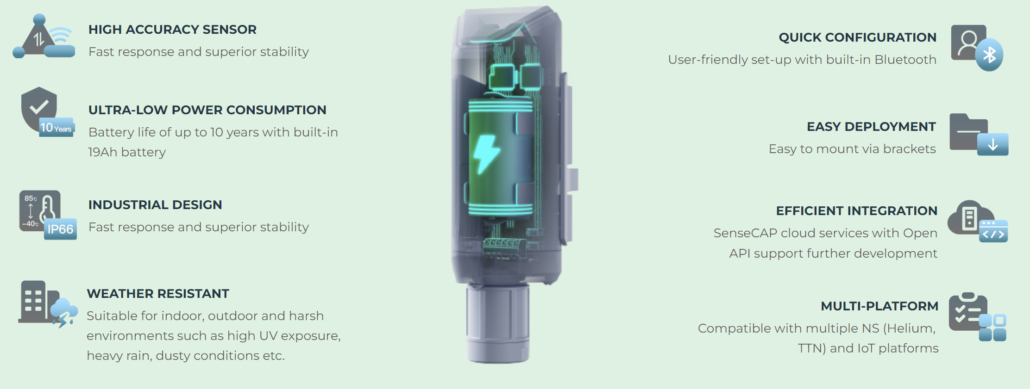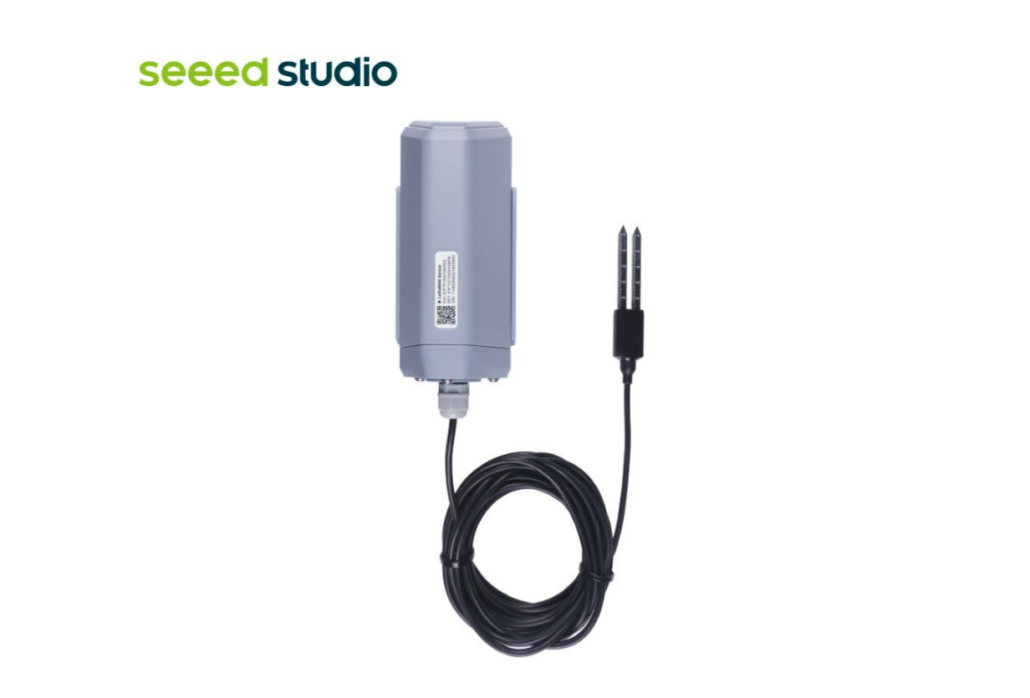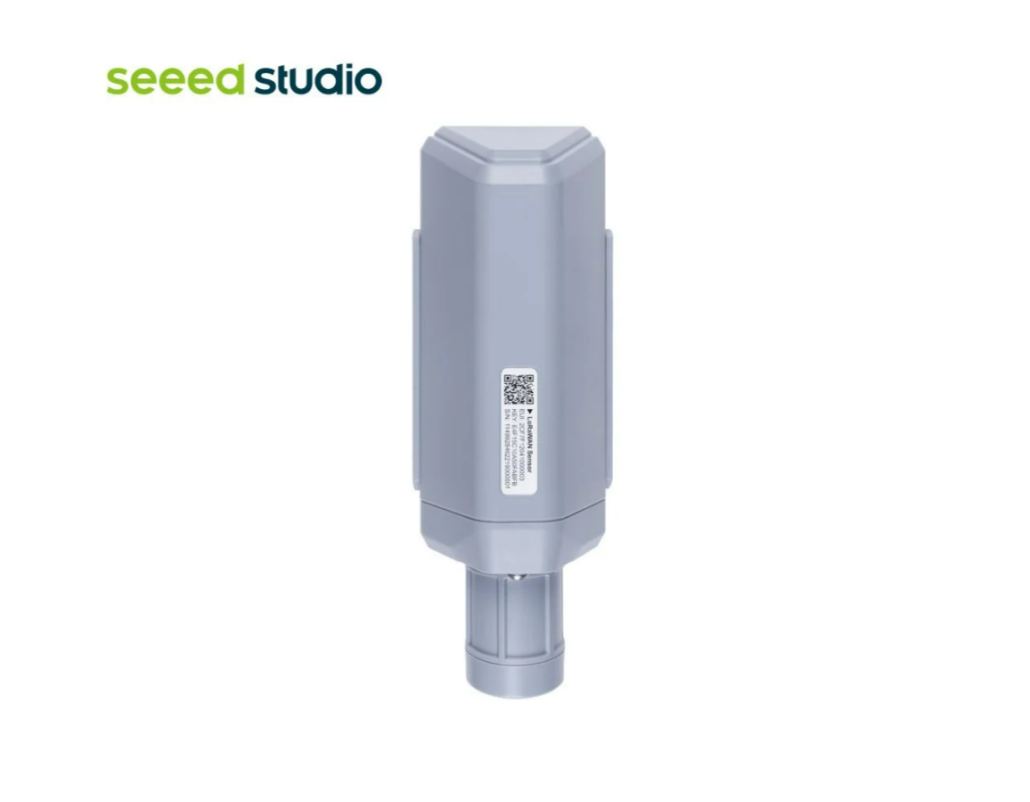A Gentle Introduction to LoRaWAN Gateways & Nodes
(Updated on 2024.4.9)
LoRa & LoRaWAN are next-generation technologies that will support wireless connectivity in IoT, alongside 5G RF Technologies. Uniquely enabling long-range, low-power communication, they are already being used in numerous consumer and industrial applications to solve real-world problems. For beginners in the space, however, getting started with LoRa & LoRaWAN can be an intimidating process. This article serves as a more in-depth but gentle introduction to LoRaWAN Gateways & Nodes, as well as a guide on how to get started!
We will cover the following content and more!
- Recap: What is LoRa & LoRaWAN?
- What are LoRaWAN Gateways & Nodes?
- Benefits of using LoRaWAN Gateways with End Nodes
- LoRaWAN Product Recommendations
- How to Set Up a LoRaWAN Gateway with Raspberry Pi
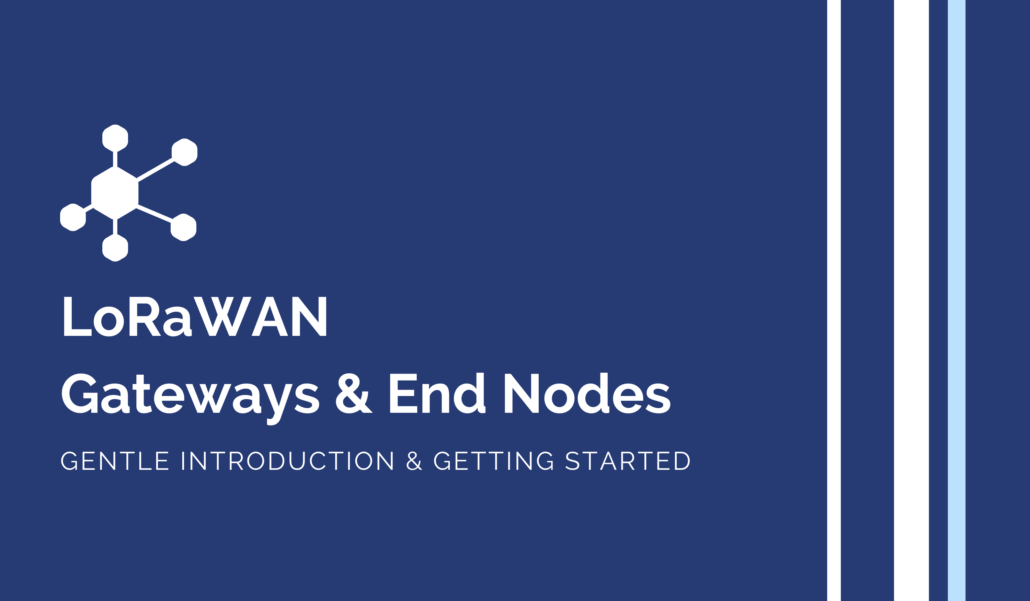
What is LoRa & LoRaWAN?
LoRa, which is short for Long Range, is one of the major long-range and low-power wireless communication systems developed by Semtech Corporation. While LoRa & LoRaWAN are commonly mistaken to be the same thing, they actually represent different components of a LoRa-based communication system.
LoRa is a radio frequency carrier signal based on the physical (PHY) layer that converts the data it receives to signals. On the other hand, LoRaWAN is a protocol located in the Media Access Control (MAC) layer that promotes LR signals to wider applications.
In simple terms, you can understand LR to be a type of hardware that supports long-range wireless communication, whereas LoRaWAN refers to a network protocol based on LoRa.
Together, LoRa & LoRaWAN allow long-range, low-power applications to be built for IoT, enabling wireless transmission over distances of up to 15km! Among other benefits and features shown below, they are also suitable for a wide range of applications; indoors and outdoors.
Supported by a diverse ecosystem of hardware and software developers, network providers and industry associations, as well as the LoRa Alliance®, LR technologies are increasingly accepted and easier to implement worldwide. Hence, anyone choosing to get started with LoRaWAN can expect to rely on extensive documentation and community support with platforms like The Things Network (TTN).
What are LoRaWAN Gateways & Nodes?
LoRaWAN Gateways and Nodes are two of four key components of the LoRaWAN network architecture:
- End Nodes – Represents edge devices or sensors
- Gateway – Collects or concentrates data from several end nodes
- Network Server – Consolidates data from gateways for upload to the application server
- Application Server – Processes or displays consolidated data
As you see, LoRa Gateways and End Nodes exist in the physical space of deployment, which makes them suitable to discuss together!
LoRaWAN End Nodes
End Nodes (such as our SenseCAP S210X Series LoRaWAN Sensor Nodes) refer to devices at the end of the network, which are equipped with sensors to collect and monitor data. They usually come in the form of low-power microcontrollers that can be deployed for years without any requirement for maintenance and are equipped with a LoRa transmitter to send data packets to the Gateways. End Nodes can be deployed anywhere – security or safety monitoring systems, vending machines, and even asset tracking (such as our SenseCAP T1000 LoRaWAN Tracker) are just some examples of where they can be placed!

Wio-E5 & Wio-E5-LE LoRa Module, the LoRa transmitter for SenseCAP S210X LoRaWAN Nodes
LoRaWAN Gateways
LoRaWAN Gateways are the bridge between End Nodes and the Network. To receive information from the End Nodes, gateways are equipped with a LoRa concentrator and can, in essence, be considered as a router of sorts. Two primary types of LoRaWAN Gateways are differentiated by their type of software:
- Minimal firmware that only runs the packet forwarding software to the network server.
- Operating system where the packet forwarding software is run in the background. While this consumes more power, gateway administrators are able to utilize the gateway device for other purposes.
It is important to distinguish that LoRaWAN End Nodes communicate with LoRaWAN Gateways through low-power LoRaWAN, whereas Gateways communicate with the Network Server through higher bandwidth communication protocols like WiFi, Ethernet, or Cellular.
Benefits of using LoRaWAN Gateways with End Nodes
Now, the use of LoRaWAN Gateways as an intermediary between End Nodes and the server are in no way arbitrary. In fact, LoRaWAN Gateways enable what is known as a star-on-star network, which has several key benefits!
1. Redundancy to Ensure Minimal Service Disruptions
When an Edge Node on the LoRaWAN network broadcasts data through LR, all gateways within the range of that device will receive its messages and forward them to the network server! The network server will then deduplicate the messages and choose the best gateway to transmit a downlink message back to the End Node if required.
For a network targeted at industrial IoT solutions, this is a major advantage. For one, any faults in a single LoRaWAN Gateway will not cause the system to fail, since other gateways can continue to receive data from the End Nodes. This also makes it easier to maintain the Gateways since the system won’t have to be shut down during maintenance.
Overall, the usage of LoRaWAN Gateways helps to keep the network reliable and operating with minimal service disruptions!
2. Maximum Affordability & Scalability
Each LoRaWAN Gateway is relatively affordable and can service up to 1000 additional End Nodes. With the LoRaWAN network topology, wireless network coverage can be increased easily and affordably without disturbing the network! Thus, the LoRaWAN network can be easily scaled to suit the needs of any application or environment.
3. Ever-Expanding Global Network
LoRaWAN operates on an unlicensed radio band, which allows us to operate LoRaWAN gateways in most countries legally and at no cost! If there is no coverage where you are located, you can simply add your own gateway, which you and others in your area can then use! With a strong community and support from the LoRa Alliance®, LoRaWAN networks continue to grow as we speak!
How is LR currently being used?
Boasting vast flexibility in long range low power communication, LR is suitable for use in numerous monitoring applications including healthcare, agriculture, smart cities, metering, as well as supply chain & logistics! Thus, it’s commonly said that the applications of LR are limitless, but there are indeed a few scenarios where its capabilities truly shine.
When Other Communication Methods are Unsuitable
Such applications include agriculture, or environmental monitoring in rural areas where there is no satellite signal for cellular communication, nor the infrastructure for short-range communications like Wi-Fi routers and access points.
In fact, it is for this reason that LR is particularly powerful for smart metering applications in buildings. Due to the long range nature of LR , only a single gateway is required to receive electrical / water consumption data from all meters in the building. This significantly reduces the cost of network infrastructure in comparison to Wi-Fi. Furthermore, LR much more suitable for indoor usage, which is a scenario where cellular connectivity commonly struggles!
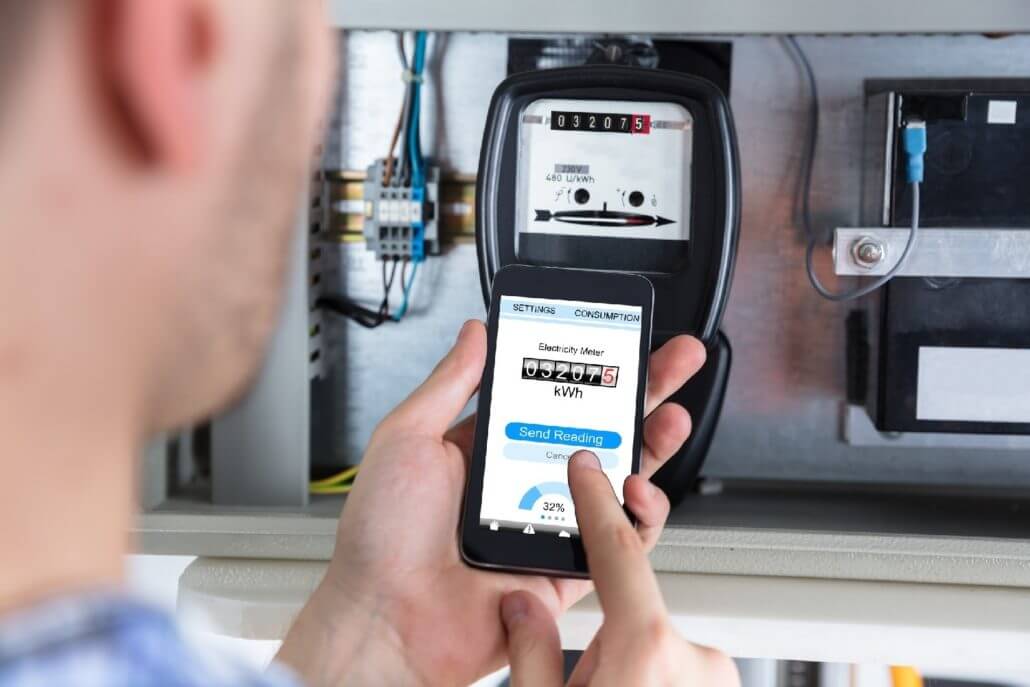
When there are Strict Requirements to be Met
LR & LoRaWAN infrastructure is built to be robust and operational for years and years. Thus, it is the perfect choice for industrial use cases where network failures are absolutely unacceptable. This may include surveillance systems, emergency alert systems, and agricultural monitoring systems, where an assurance of operational reliability is a must. Thanks to the same characteristics, LR devices are also prime candidates for field deployment applications like remote logistics and supply chain tracking and wearables.
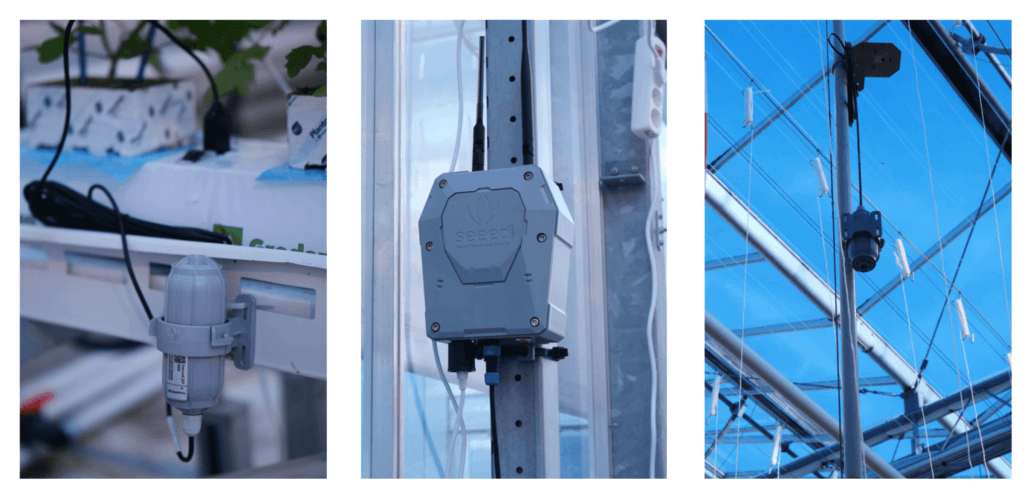
When Network Privacy is Needed
LR enables individuals and businesses to easily build their own networks for internal use with dedicated hardware and infrastructure. Not only is this a more affordable solution than seeking enterprise products on the market, it also grants users greater flexibility and management capabilities with the system. Isolated from external intervention and networks and equipped with integrated encryption capabilities, a LoRaWAN private network also improves data security for the information that is transmitted on it.
LoRaWAN Gateways & End Nodes: Recommendations
LoRaWAN networks are designed to last, but only if you invest in the right hardware. At Seeed, we are committed to delivering industrial-grade products to enable IoT solutions built on various networks, including LR & LoRaWAN! Here are some of our top recommendations for building your own LoRaWAN Gateways and End Nodes!
Wio-E5 LoRa Module & Wio-E5-LE LoRa Module
The Wio-E5 wireless module is embedded with the ST system-level package chip STM32WLE5JC, ARM Cortex M4 ultra-low-power MCU, and Long Range SX126X. It supports LoRaWAN frequency plan on EU868, US915 and more. It is FCC, CE, IC and TELEC certified, marking Wio-E5’s quality as reliable and worth buying.
Why are there two versions, Wio-E5 and Wio-E5-LE?
Due to the requirements of the European Union’s Conformité Européenne (CE) certification, the maximum output power for LoRa is 14dBm, while the output power of Wio-E5 is 22dbm. Therefore, to accommodate European users, wo developed Wio-E5-LE, with a maximum output power of exactly 14dbm and lower power consumption. In transmission mode, it only requires 26mA, which is a 76% reduction compared to Wio-E5.
Product feature
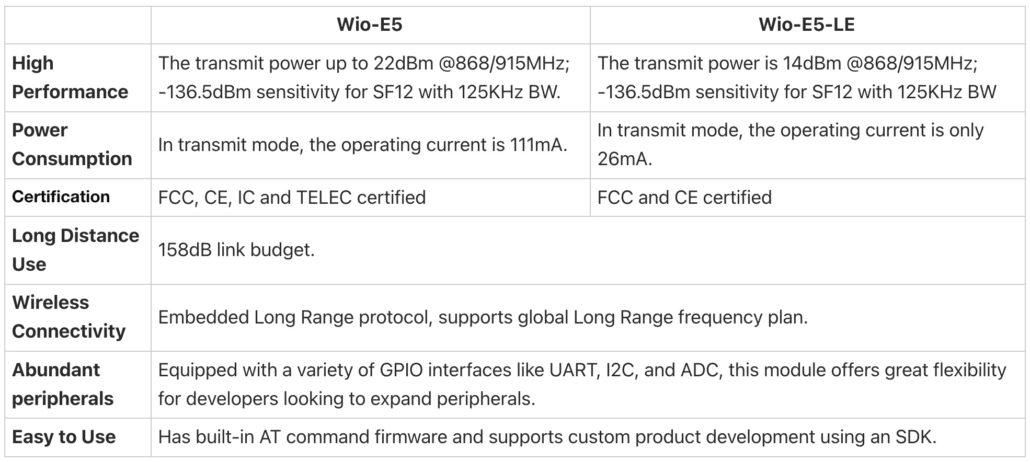
If you are interested in Wio-E5 please click here. If you are interested in Wio-E5-LE click here.
Grove – Wio-E5 (STM32WLE5JC)
If you want to build a LR End Node solution with an SBCs like the popular Raspberry Pi 4, or a microcontroller like the Wio Terminal, the Wio-E5 Grove module will be your best bet. Featuring full LoRaWAN capabilities in the modular simplicity of the Grove ecosystem, the Grove Wio-E5 lets you bring your existing devices into your LoRaWAN network with just a few simple steps!
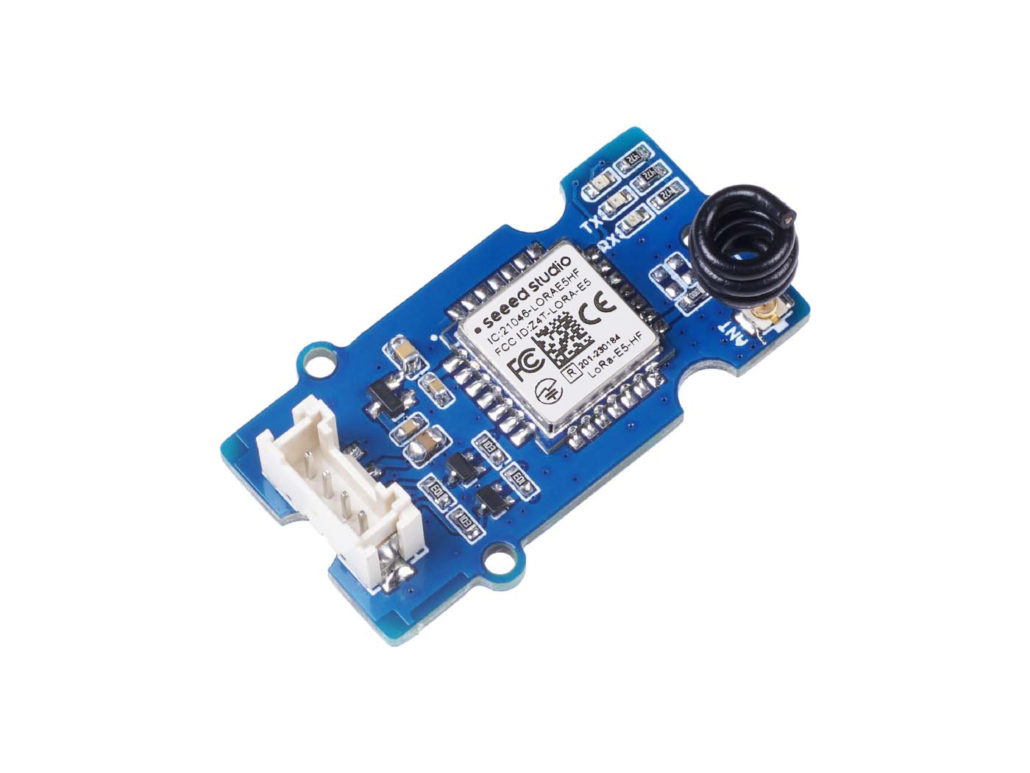
Product Features:
- Wio-E5 (STM32WLE5JC) embedded
- Support LoRaWAN protocol on EU868/US915 frequency band
- Ultra-long transmitting range up to 10km (Ideal value in open space)
- Easy control by AT command via UART connection
- Rapid prototyping with plug-and-play Grove interfaces
- Ultra-low power consumption and high performance
Visit the Seeed Online Store to learn more about the Grove Wio-E5 Module today!
Wio-E5 mini Dev Board
The Wio-E5 mini Dev Boardis a compact development board. It exposes all of Wio-E5’s GPIO, including UART, ADC, SPI, I2C, and comes with RESET and BOOT buttons. It provides developers with a highly flexible way to work. So, it’s an ideal choice for building small prototypes, helping you design the perfect long-range wireless IoT device and extending the transmission range.
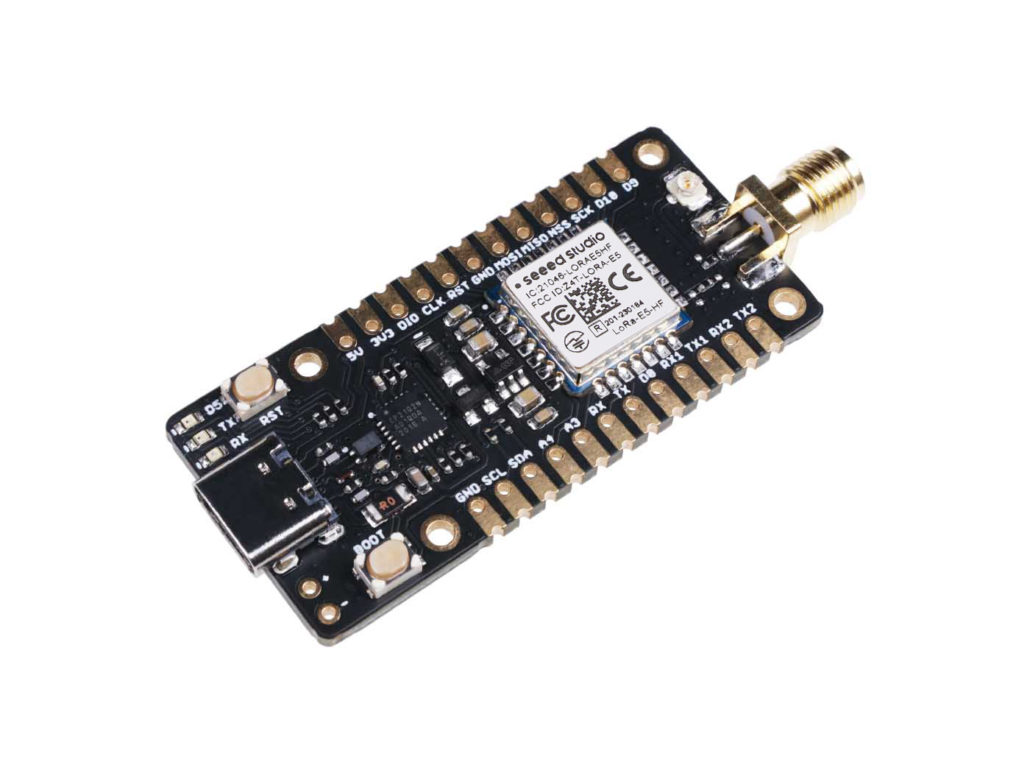
Product Feature:
- Ultra-low power consumption and high performance
- Easy testing and rapid prototyping
- Introduced UART, ADC, SPI, I2C, etc. of WIo-E5. It includes RESET and BOOT buttons, making it user-friendly.
- Global LoRaWAN® and LR frequency plan supported
- Long-distance transmission range to 10km (ideal value in open area)
To learn more about the Wio-E5 Mini Dev Board, please visit this page.
Wio-E5 Development Kit
The Wio-E5 Development Kit consists of the Wio-E5 Development board, an antenna, a USB Type C Cable and a 2*AA 3V Battery Holder. The Wio-E5 Dev Board is embedded with the Wio-E5 STM32WLE5JC module with LoRaWAN protocol compatibility on the global frequency band. In addition, it supports various data protocols and interfaces, such as full GPIOs, RS-485 and Grove!
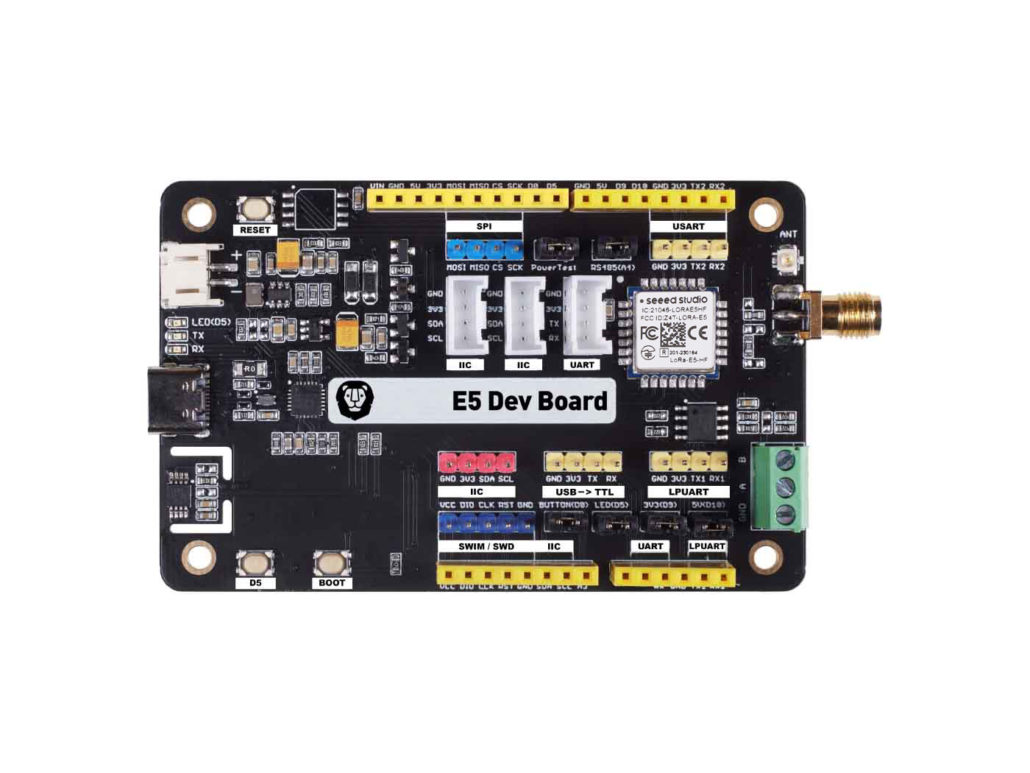
Product Features:
- Ultra-low power consumption and high performance
- Easy testing and rapid prototyping
- Full GPIOs that lead out to rich interfaces, including RS-485, Grove, and etc.
- Global LoRaWAN® and LR frequency plan supported
- Long-distance transmission range to 10km (ideal value in open area)
If you’re keen to pick up the Wio-E5 Development Kit, visit the Seeed Online Store now!
WM1302 LoRaWAN Gateway Modules
Our new WM1302 modules are the next-generation of mini-PCIe form-factor LoRaWAN gateway modules that have been carefully designed to unlock greater possibilities in long-range wireless transmission. Powered by the brand new Semtech® SX1302, the WM1302 series features improvements in sensitivity, power consumption and thermal management over older models with SX1301 and SX1308 chips!
Product Features:
- Powered by the Semtech® SX1302 baseband LoRa® chip, bringing extremely low power consumption while delivering high performance.
- Mini-PCIe form factor with standard 52-pin golden finger for space saving and seamless integration with various gateway devices.
- Ultra-low operating temperatures, with no need for additional thermal management, keeping your LoRaWAN gateways compact!
- High sensitivity down to -139dBm @ SF12 with SX1250 TX/RX front-end; Transmission power of up to 26dBm @ 3.3V.
- Certified with CE, FCC, and TELEC to simplify your product development and certification processes.
You can easily combine the WM1302 LoRaWAN Gateway Module with everyone’s favourite Raspberry Pi 4 by using the WM1302 Pi Hat to create your very own LoRaWAN Gateway! To learn more about the WM1302 LoRaWAN Gateway Modules, visit their product page on the Seeed Online Store!
SenseCAP M2 Multi-Platform LoRaWAN Indoor Gateway
SenseCAP M2 Multi-Platform LoRaWAN Gateway is a standard LoRaWAN gateway that supports connecting to different network servers. It supports global LoRaWAN frequency plans from 865 MHz to 923 MHz and can be used in multiple LoRaWAN applications like smart building, environmental monitoring systems, precision farming, etc.
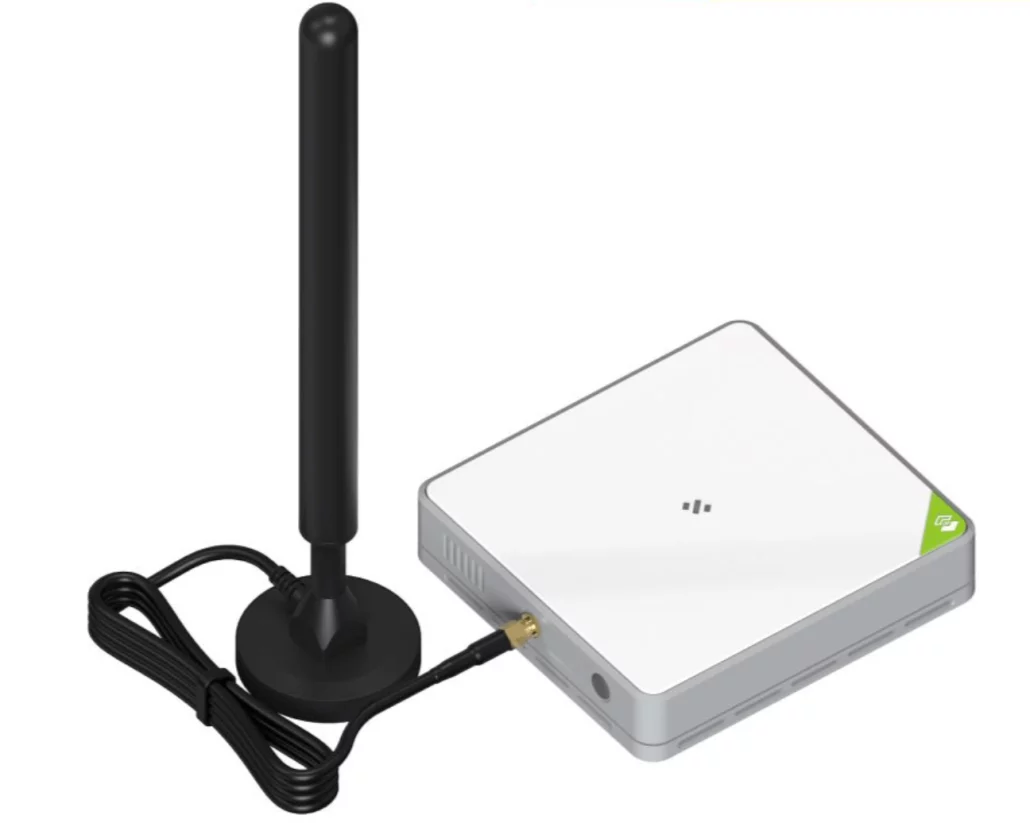
Product feature
- Up to 10km of LoRaWAN® coverage and strong signal, allowing users to send data with extremely long ranges at low data rates.
- Compatible with multiple LNS like AWS, TTN, ChirpStack, etc. via using the Packet Forwarder / Basic Station mode.
- Based on Chirpstack, provides a fast and reliable solution for launching a LoRaWAN network.
- The PoE feature is also added to this device, making your deployment more reliable and faster.
- Supports Cellular(optional)、Wi-Fi and Ethernet for internet backhaul.
To learn more about the SenseCAP M2 Multi-Platform Indoor Gateway, click the product page on the Seeed Online Store.
SenseCAP LoRaWAN Starter Kit
SenseCAP LoRaWAN Starter Kit for SenseCAP multi-platform gateway assembles the Seeed Studio XIAO ESP32-S3, XIAO’s Expand board, Grove-Wio-E5 and two grove sensors in one box which is designed specifically for beginners. With this kit, you can learn and experience the entire architecture of LoRaWAN. You can also utilize the grove sensors provided in the kit or choose your own sensor modules to build your own LoRaWAN projects.
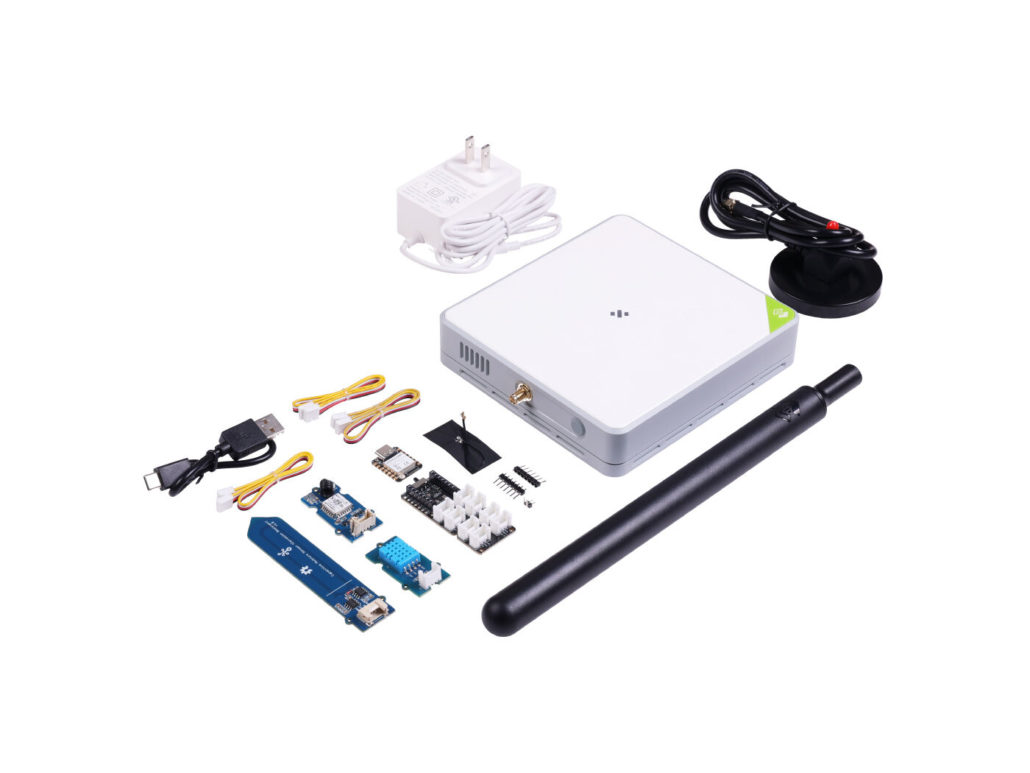
- Build a LoRaWAN project through 4 steps in 10 minutes and can visualize data on the Cloud platform
- Compatible with different types of LoRaWAN® network servers making it suitable for a wide range of applications and industries
- Compatible XIAO ESP32S3 board offers various data transmitting interfaces and functional peripherals, compatible with Arduino
- With built-in AT command firmware, the board simplifies application development for developers, offering a seamless and flexible experience
- By updating the firmware through UF2, easily make it compatible with other Grove sensors
- Plug and Play in just four steps, no programming background is required
Click here to learn more about LoRaWAN Starter Kit!
LoRaWAN Industrial-level Soil Moisture, Temperature, and EC Sensor
SenseCAP S2105 Soil Temperature, Moisture, and EC Sensor satisfy industrial long-distance data acquisition with a wide range of 0 ~ 100% (m³/m³), -40 ~ 80℃, and 0 to 23 dS/m respectively. With Bluetooth 5.0 for easy configuration and firmware upgrade and a built-in replaceable battery for minimal maintenance, it also supports three different LoRaWAN network architectures enabling you to easily join it in existing gateways and network servers to build flexible and high-performance sensor network.
SenseCAP S2103- LoRaWAN CO2, Temperature, and Humidity Sensor
SenseCAP S2103- LoRaWAN CO2, Temperature, and Humidity Sensors satisfy industrial long-distance data acquisition with a wide range of 400 to 10000 ppm, -40°C to 85°C and 0 to 100% RH respectively. With Bluetooth 5.0 for easy configuration and firmware upgrade and a built-in replaceable battery for minimal maintenance, it also supports three different LoRaWAN network architectures enabling you to easily join it in existing gateways and network servers to build flexible and high-performance sensor network.
S210X series is a brand new series of environmental sensors that enable long-distance data acquisition via LoRaWAN. They can be applied to a wide variety of industry verticals such as smart agriculture, smart buildings, and industrial control. Check more details.
Note: A full LR system will require four key components: End nodes, gateway, network serve and application server. For our full list of products for each category, please visit their corresponding links!
- LoRa Modules
- LoRa Dev Boards & Dev Kits
- LoRa Sensor Nodes (Devices)
- LoRa Gateways
- LoRa Accessories
- Industrial-grade LoRaWAN Products for Outdoor Applications
Tutorial: Set Up a LoRaWAN Gateway with Raspberry Pi!
In this section, I will show you how you can easily set up a LoRaWAN Gateway to receive and forward data from your LR end nodes!
Required Materials
To follow along with this tutorial, you might want to consider picking up the following items:
- Raspberry Pi 4 4GB
- WM1302 Raspberry Pi Hat
- WM1302 Gateway Module (US915 / EU868)
The WM1302 Gateway Module uses a standardized mini-PCIe form factor, so you can use any device with a compatible interface! For ease of use and to keep it beginner-friendly, the Raspberry Pi will be our choice for this project!
Getting Started
This section is still under development – please check back shortly! For now, check out the Seeed Wiki for more information!
Summary
That’s it for this article! I hope you’ve gotten a clearer idea of the roles of LoRaWAN Gateways & End Nodes in a LoRaWAN network. The world of LR is continuously growing, and will only play a more important role in the coming future of Industrial IoT! If you’re keen to learn more about LoRa, LoRaWAN, or IoT in general, you might be interested in reading the following articles:
- How to Enable LR and LoRaWAN on Arduino and Raspberry Pi
- LoRa & LoRaWAN: Vertical Solutions for the Real World
- Edge AI – What is it and What can it do for Edge IoT?
- What is Industry 4.0? – Technologies of the Fourth Industrial Revolution
